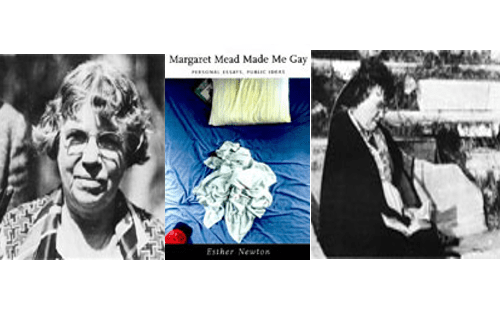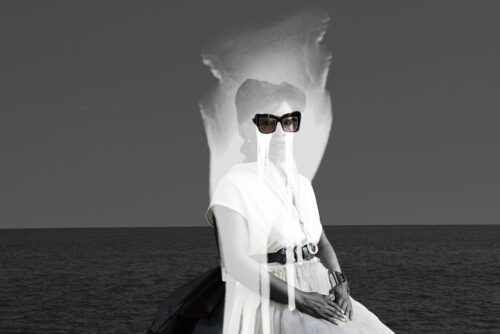Josephine’s first manner—jumping from one race to the other, from one continent to the other—brought us in touch with an unconscious that “displaces lines,” jostles our ways of seeing, calls us back to the primitive order.
—Pierre Mac Orlan, in Les Mémoires de Joséphine Baker, 20 1
I learned at the cinema what a nigger was.
—A nigger over here, Marc Allégret shouted, a nigger over there. Bring me a nigger … Hand over the nigger…
I was waiting for the nigger. I am given an explanation…. It was a blackboard on which were written the actors’ dialogues.(Les Mémoires de Joséphine Baker, 157)
What can Princess Tam Tam, a film about how to overcome writer’s block that features Josephine Baker in the role of foil, tell us about creation in relation to “racial” and sexual difference? In 1935, exactly a decade after her scandalous appearance in La Revue Nègre, Baker was at the height of her success. She had appeared in a successful film Zou Zou in 1934 and been offered the lead role of Dora in Offenbach’s La Créole that same year. As numerous critics have observed, a Pygmalion plot line informs Princess Tam Tam, but it is the narrative “reality” of the muse as a “source of inspiration”—the name of Baker’s character’s name is Alwina, or “little spring”—that lies at the core of the film’s dénouement. 2 Had Max de Mirecourt, the afflicted Parisian writer, not encountered Alwina, he would not have written the novel that eventually helps him regain his wife’s affection. His secretary, Coton, admits at one point that “these race stories can make a very fashionable novel,” thus underscoring the topicality of the racial theme in France of the 1930s. 3 This topicality must in turn be applied to the film. The novel itself (l’objet-livre), the book as material object, ultimately devoured by Alwina’s mindless donkey, appears as a mere pretext for the reunion of the Parisian socialite couple. However, as a film segment, the fictitious transformation of Alwina into an Indian princess, and her subsequent triumph as an inspired natural performer of the conga, parallels Baker’s own career in reverse. She first performed la danse sauvage with her Antillean partner Joe Alex as a tableau in La Revue Nègre and became famous overnight. That performance propelled her to stardom.
The three films that remain linked to Josephine Baker’s early career are all vehicles for her talent as a performer and a singer. They all mimic—or rather introduce—fictional variations of her real-life rise from the suburbs of East St. Louis to the glory of an international career. In Siren of the Tropics (1927), she lives in a Spanish-speaking West Indian island and pursues her lover to Paris, where her dancing makes her famous. In Zou Zou (1934) she is a laundress who ends up standing in for the capricious star of a show when the latter runs away with a lover. In Princess Tam Tam, the final dance reveals that the Princess of Parador is a sham, and it marks the end of Max de Mirecourt’s novel, which is aptly titled Civilization. The veneer of civilization cracks to reveal Alwina’s “true” nature. To perform her act, she frantically flings her shoes away, tears off her clothes, and enacts the primal scene of the near-naked dancing black female. Princess Tam Tam is thus unique in its conscious play on fiction (Baker as a naïve savage girl) as foil for the real (Baker as an international star), on failure and success (Max) as a foil for genuine artistic talent (Baker). In the film, the complex relation between desire and creation within the context of colonial phantasm in which Baker’s success is inscribed, clearly maps out the fantasy at the core of the viewer’s fascination with the black star. 4
The fact that there was a real-life Baker who became a star—what could be called the “resistance of the referent” or “the stubbornness of the referent,” to borrow Roland Barthes’s terminology—undermines the overtly racist, Orientalist reading of the film’s narrative. 5 Moreover, Alwina’s transformation coincides with what Barthes would call a biographème, or “biographic traits within a writer’s oeuvre,” a term that must be applied in the present case to Baker the artist. 6 As a young girl, Baker, Cinderella-like, dreamed of princesses and fairy tales: “Queens were blond, they would go down massive stairs. There were always steps and steps. Thus neither the kings nor the queens would come up to meet me” (M, 390). 7 Stairs would feature prominently in her performances, many of which had at their core the star walking down stairs, a number that Mistinguett initiated in the French music hall. 8 Since kings and blond queens refused to come to her, the African-American Baker changed herself into a movie princess, as in Princess Tam Tam, and in life, as her worldwide success attests. 9
The film does not purport to be more than entertainment and a tribute to Baker’s talent. Pepito Abatino, Baker’s agent and companion at the time, feared that Baker’s success might be short-lived. Consequently, he pushed her beyond dancing, to sing and then to star in silent and motion pictures. This initiative firmly grounded Baker in the artistic and cultural life of the 1930s. Far from singular, Baker’s progress is symptomatic of the evolution of music hall artists of the period. Jean Gabin’s career evolved along similar paths. The son of a comedian, Gabin started as a music hall artist—in Zou Zou, he sings the number “Viens Fifine” (“Come Little Josephine”)—and subsequently became a star. The queen of the music hall and French rival to Baker, Mistinguett also starred in numerous films. Thus, the relation of muse to Pygmalion in the film repeats Baker’s relation to Abatino, the “no-account count” who was her mentor in the early days of her French career, while Baker’s presence in the motion picture arena reflects a more general evolutionary trend in the French entertainment scene.
- The quotations are from the following edition: Les Mémoires de Joséphine Baker, collected and adapted by Marcel Sauvage (Paris: Dilecta, 2006), hereafter referred to as M. The translations are mine. Princesse Tam Tam was directed by Edmond T. Gréville (Arys Production, 1935). All references to Princess Tam Tam are to the 2005 Kino version.[↑]
- Aouina, the French transcription of the Arabic, is spelled “Alwina” in the Kino DVD version. That the name has been chosen on purpose is made clear by a reference in the film to Alwina as a “source of trouble” by Coton. See Bennetta Jules-Rosette, Josephine Baker in Art and Life: The Icon and the Image (Champaign-Urbana, IL: University of Illinois Press, 2006), p. 95.[↑]
- A la page means somebody who follows the fashion of the day according to the books.[↑]
- Freudian terminology is used throughout the text, and “phantasm” is consequently defined in light of Jean Laplanche, J.B. Pontalis and Gilles Deleuze’s work as a “scene.” The evolution of the Freudian notion from a real seduction of the daughter (the seduction theory) to a construction is crucial to the understanding of the concept. Phantasms of seduction are disguises. See Laplanche and Pontalis, “Phantasme originaire, phantasme des origines et origines du phantasme” Les Temps modernes 19 (1964) 1833-68; English translation: “Fantasy and the Origins of Sexuality,” The International Journal of Psychoanalysis 19:1 (1968) 1-18; Gilles Deleuze, Différence et répétition (Paris: PUF, 1968); Logique du sens (Paris: Editions de minuit, 1969). Alwina’s seduction by Max de Mirecourt is the phantasm transcribed in his novel.[↑]
- See Roland Barthes, La Chambre claire: note sur la photographie (Paris: Gallimard Seuil, 1980), p. 17. See also Claudine Raynaud, “Visual and Textual Selves” in Peter Vernon, ed. Seeing Things: Literature and the Visual, Papers from the Fifth International British Council Symposium, GRAAT 19, Tours: PUFR, 2005, 45-59.[↑]
- Roland Barthes, La Chambre claire: Note sur la photographie (Paris: Gallimard Seuil, 1980), p. 54.[↑]
- On the notion of star and stardom in French films of the period, see Claude Gauteur and Ginette Vincendeau, Jean Gabin: Anatomie d’un mythe (Paris: Editions nouveau monde, 2006).[↑]
- Elisabeth Coquart and Philippe Huet, Mistinguett: La Reine des années folles (Paris: Albin Michel, 1996).[↑]
- Her preface to Mon sang dans tes veines (Paris: Isis, 1931) explains that the heroine Joan would have preferred the country of Devotion (le pays du Dévouement) to the pearls and diamonds showered on her: “While biting into fruit stolen here and there from large baskets, Joan and I made a thousand plans to escape along the big river, and to flee an unjust continent. … We would reach a country where they would treat us like fairy tale princesses. We would dance, we would sing, covered with diamonds, pearls, and feathers, under lights much brighter than African suns” (p. 6, translation mine).[↑]



